AMD Kaveri Review: A8-7600 and A10-7850K Tested
by Ian Cutress & Rahul Garg on January 14, 2014 8:00 AM ESTThe GPU
AMD making the move from VLIW4 to the newer GCN architecture makes a lot of sense. Rather than being behind the curve, Kaveri now shares the same GPU architecture as Hawaii based GCN parts; specifically the GCN 1.1 based R9-290X and 260X from discrete GPU lineup. By synchronizing the architecture of their APUs and discrete GPUs, AMD is finally in a position where any performance gains or optimizations made for their discrete GPUs will feed back into their APUs, meaning Kaveri will also get the boost and the bonus. We have already discussed TrueAudio and the UVD/VCE enhancements, and the other major one to come to the front is Mantle.
The difference between the Kaveri implementation of GCN and Hawaii, aside from the association with the CPU in silicon, is the addition of the coherent shared unified memory as Rahul discussed in the previous page.
AMD makes some rather interesting claims when it comes to the gaming market GPU performance – as shown in the slide above, ‘approximately 1/3 of all Steam gamers use slower graphics than the A10-7850K’. Given that this SKU is 512 SPs, it makes me wonder just how many gamers are actually using laptops or netbook/notebook graphics. A quick look at the Steam survey shows the top choices for graphics are mainly integrated solutions from Intel, followed by midrange discrete cards from NVIDIA. There are a fair number of integrated graphics solutions, coming from either CPUs with integrated graphics or laptop gaming, e.g. ‘Mobility Radeon HD4200’. With the Kaveri APU, AMD are clearly trying to jump over all of those, and with the unification of architectures, the updates from here on out will benefit both sides of the equation.
A small bit more about the GPU architecture:
Ryan covered the GCN Hawaii segment of the architecture in his R9 290X review, such as the IEEE2008 compliance, texture fetch units, registers and precision improvements, so I will not dwell on them here. The GCN 1.1 implementations on discrete graphics cards will still rule the roost in terms of sheer absolute compute power – the TDP scaling of APUs will never reach the lofty heights of full blown discrete graphics unless there is a significant shift in the way these APUs are developed, meaning that features such as HSA, hUMA and hQ still have a way to go to be the dominant force. The effect of low copying overhead on the APU should be a big break for graphics computing, especially gaming and texture manipulation that requires CPU callbacks.
The added benefit for gamers as well is that each of the GCN 1.1 compute units is asynchronous and can implement independent scheduling of different work. Essentially the high end A10-7850K SKU, with its eight compute units, acts as eight mini-GPU blocks for work to be carried out on.
Despite AMD's improvements to their GPU compute frontend, they are still ultimately bound by the limited amount of memory bandwidth offered by dual-channel DDR3. Consequently there is still scope to increase performance by increasing memory bandwidth – I would not be surprised if AMD started looking at some sort of intermediary L3 or eDRAM to increase the capabilities here.
Details on Mantle are Few and Far Between
AMD’s big thing with GCN is meant to be Mantle – AMD's low level API for game engine designers intended to improve GPU performance and reduce the at-times heavy CPU overhead in submitting GPU draw calls. We're effectively talking about scenarios bound by single threaded performance, an area where AMD can definitely use the help. Although I fully expect AMD to eventually address its single threaded performance deficit vs. Intel, Mantle adoption could help Kaveri tremendously. The downside obviously being that Mantle's adoption at this point is limited at best.
Despite the release of Mantle being held back by the delay in the release of the Mantle patch for Battlefield 4 (Frostbite 3 engine), AMD was happy to claim a 2x boost in an API call limited scenario benchmark and 45% better frame rates with pre-release versions of Battlefield 4. We were told this number may rise by the time it reaches a public release.
Unfortunately we still don't have any further details on when Mantle will be deployed for end users, or what effect it will have. Since Battlefield 4 is intended to be the launch vehicle for Mantle - being by far the highest profile game of the initial titles that will support it - AMD is essentially in a holding pattern waiting on EA/DICE to hammer out Battlefield 4's issues and then get the Mantle patch out. AMD's best estimate is currently this month, but that's something that clearly can't be set in stone. Hopefully we'll be taking an in-depth look at real-world Mantle performance on Kaveri and other GCN based products in the near future.
Dual Graphics
AMD has been coy regarding Dual Graphics, especially when frame pacing gets plunged into the mix. I am struggling to think if at any point during their media presentations whether dual graphics, the pairing of the APU with a small discrete GPU for better performance, actually made an appearance. During the UK presentations, I specifically asked about this with little response except for ‘AMD is working to provide these solutions’. I pointed out that it would be beneficial if AMD gave an explicit list of paired graphics solutions that would help users when building systems, which is what I would like to see anyway.
AMD did address the concept of Dual Graphics in their press deck. In their limited testing scenario, they paired the A10-7850K (which has R7 graphics) with the R7 240 2GB GDDR3. In fact their suggestion is that any R7 based APU can be paired with any G/DDR3 based R7 GPU. Another disclaimer is that AMD recommends testing dual graphics solutions with their 13.350 driver build, which due out in February. Whereas for today's review we were sent their 13.300 beta 14 and RC2 builds (which at this time have yet to be assigned an official Catalyst version number).
The following image shows the results as presented in AMD’s slide deck. We have not verified these results in any way and are only here as a reference from AMD.
It's worth noting that while AMD's performance with dual graphics thus far has been inconsistent, we do have some hope that it will improve with Kaveri if AMD is serious about continuing to support it. With Trinity/Richland AMD's iGPU was in an odd place, being based on an architecture (VLIW4) that wasn't used in the cards it was paired with (VLIW5). Never mind the fact that both were a generation behind GCN, where the bulk of AMD's focus was. But with Kavari and AMD's discrete GPUs now both based on GCN, and with AMD having significantly improved their frame pacing situation in the last year, dual graphics is in a better place as an entry level solution to improving gaming performance. Though like Crossfire on the high-end, there are inevitably going to be limits to what AMD can do in a multi-GPU setup versus a single, more powerful GPU.
AMD Fluid Motion Video
Another aspect that AMD did not expand on much is their Fluid Motion Video technology on the A10-7850K. This is essentially using frame interpolation (from 24 Hz to 50 Hz / 60 Hz) to ensure a smoother experience when watching video. AMD’s explanation of the feature, especially to present the concept to our reader base, is minimal at best: a single page offering the following:


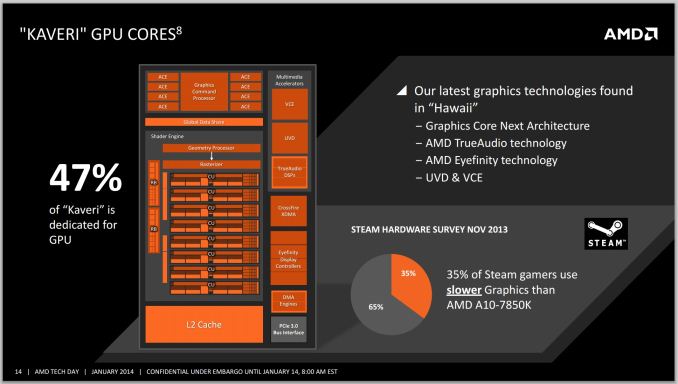
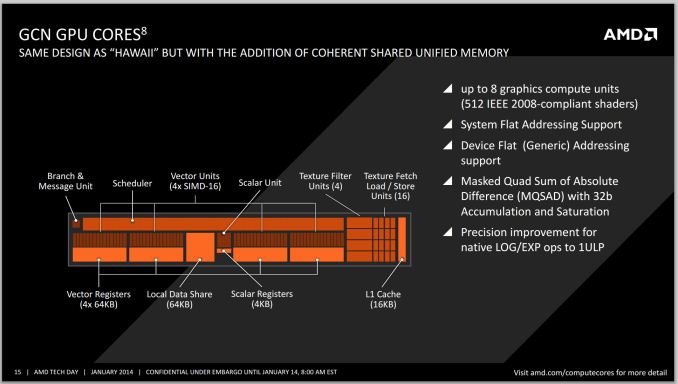
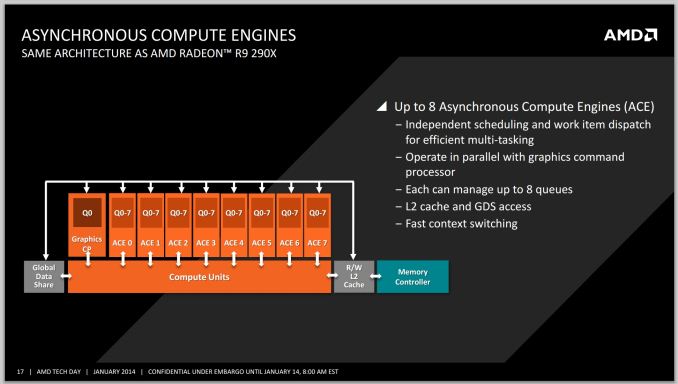
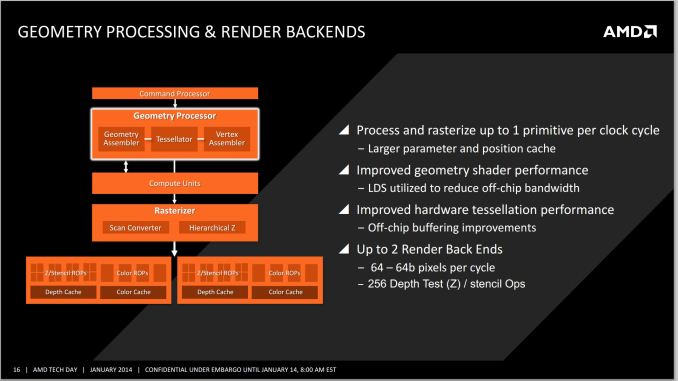
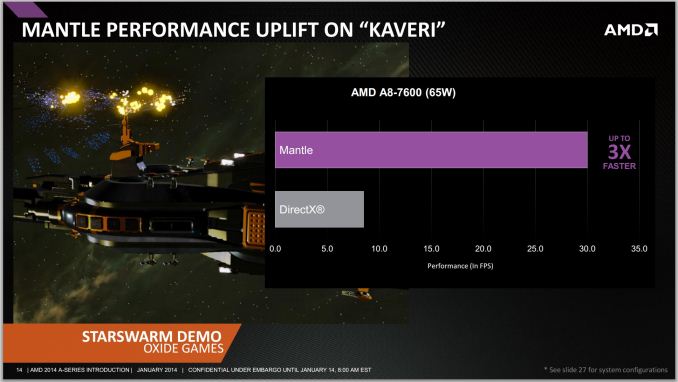
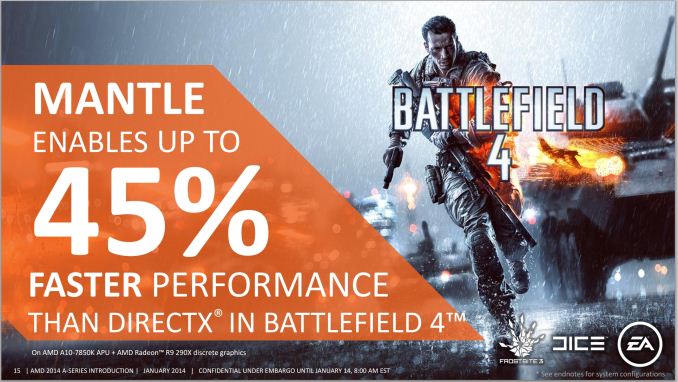
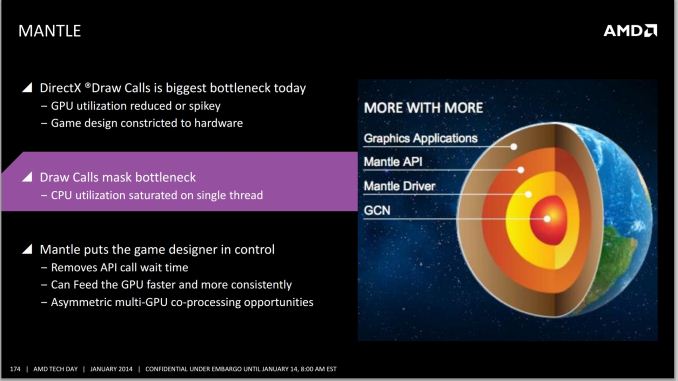
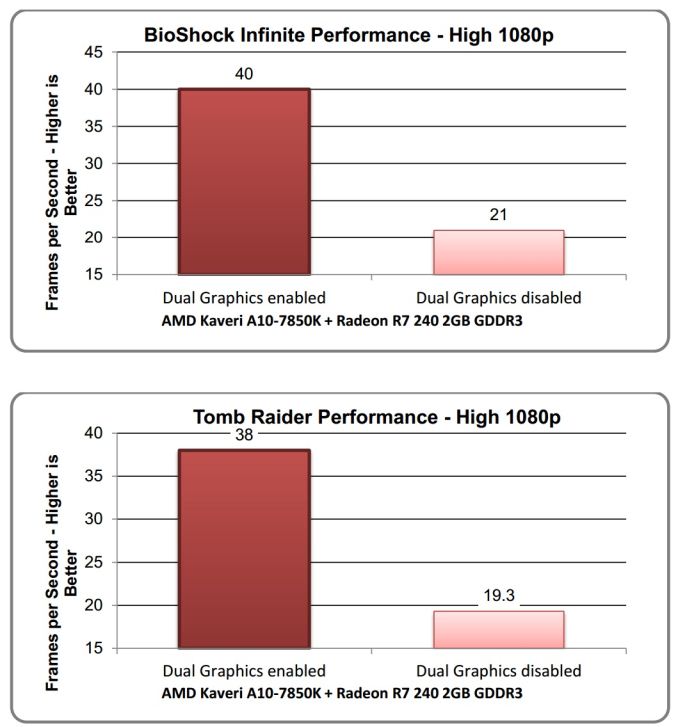
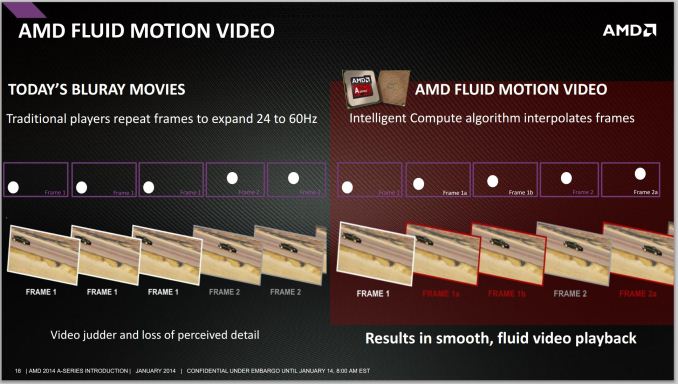








380 Comments
View All Comments
Ian Cutress - Tuesday, January 14, 2014 - link
I did a look back to C2D this time last year: http://www.anandtech.com/show/6670/dragging-core2d...When I get into the swing of testing for Gaming CPU viability again, I'll make sure it is part of the testing matrix.
ImSpartacus - Tuesday, January 14, 2014 - link
I've been reading Anadtech since I was in high school and that has to be my favorite article. I reference that article constantly.It's so hard to find reliable & exhaustive benchmarks of old CPUs. If you could update it every 2 years, I would love you forever!
just4U - Tuesday, January 14, 2014 - link
I read that article and it got me to thinking.. Maybe what is needed is not a direct comparison with new and competing products (which companies may not like..) but rather something stand alone that gets refreshed like your E6400 article. It sets the bar on what the reviewer (and likely most of us) think is needed these days..I know for myself I see a lot steps sideways in the computer industry but it's no longer leaps ahead like it once was.alyarb - Wednesday, January 15, 2014 - link
That would be great. I have a C2Q at 3.7 GHz and a 5850 at 800 MHz. Sure, that is >350W under load, but it still gets the job done at 1080p even in 2014. I have tried and can't justify replacing it all just yet.Similarly I'm not surprised to see Llano is not at the bottom of these charts and is still within striking distance of Kaveri in a lot of the tests. One day I'd like to see the past 8 or 10 years of CPUs all put through the same battery of 2013-2014 tests.
Integration and new features are all welcome, but let's take a look, as performance skeptics, at how far we've really come all this time.
anubis44 - Saturday, January 18, 2014 - link
"I have a C2Q at 3.7 GHz and a 5850 at 800 MHz. Sure, that is >350W under load, but it still gets the job done at 1080p even in 2014. I have tried and can't justify replacing it all just yet."Try playing Company of Heroes 2 (my current favourite) on that rig, and understand the meaning of the word 'obsolete'. That game will bring that system to it's knees, and it won't be pretty.
just4U - Sunday, January 19, 2014 - link
Throw in a 760 or a 280x then.. see if it's still brought to it's knees.. Hell a 270/x might do.. it's substantially faster than the 5850 as well.SofS - Friday, January 17, 2014 - link
Careful when comparing older processors regarding the memory subsystem since without the integrated controller they are very sensitive to memory performance or at least my C2Q 9550 @3410MHz seems to be. In my case the upgrade to to a G.Skill F3-12800CL6-2GBXH dual kit I made some years ago was meaningful and some other readers here on similar platforms might find that only upgrading the RAM would give them headroom enough to avoid a whole new system purchase for a while longer. Currently I also own a i7-4800MQ based notebook with dual KHX1600C9S3/8G and while noticeably faster for some cases it does not really enable me to game at higher settings than my desktop system given the GPU being a GTX 765M. Going forward a GPU upgrade to the desktop system is all I am looking for.RussianSensation - Friday, January 17, 2014 - link
Sorry, but you may have a confirmation bias here. You bought new memory expecting the system to perform much faster but years and years of personal ownership of C2D/C2Q systems and online reviews show that it hardly performed faster with faster memory. That architecture in fact performed faster with tighter latency. Your kit doesn't even have 5-5-5-15 timings. C2Q 9550 @ 3.4ghz is a slow CPU compared to Core i7 4770 @ 4.5ghz for gaming. Your memory upgrade may have netted you an extra 2-3% increase on average at best.SofS - Friday, January 17, 2014 - link
Come to think of it, maybe the amount was more important, besides going down to CL6 previously it was 2x1GB instead of 2x2GB. If that is the case then my 765M must be holding the 4800MQ back for gaming or something else is very wrong. Currently the only games I play that do not perform properly at 1080p are Witcher2 and Tomb Raider, probably that has more to do with the GPU than the CPU/RAM tough the real question is if a better next generation mid range GPU would still be able to work properly with them.Albangalo - Wednesday, January 15, 2014 - link
While it's not to do with Kaveri, Tom's Hardware did some articles comparing current cpus with older ones:Intel Ivy vs c2d & c2q: http://www.tomshardware.com/reviews/ivy-bridge-wol...
AMD fx vs k10: http://www.tomshardware.com/reviews/piledriver-k10...